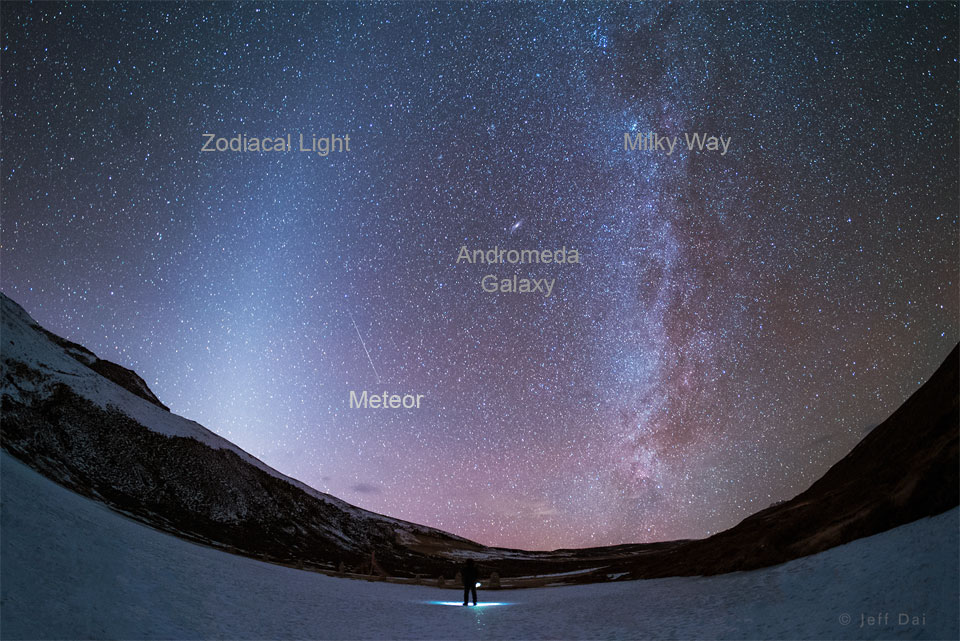01. March 2022
Tī 夜空決鬥 ê 兩條光帶

探索宇宙1!逐工會揀一幅無仝款 ê 影像抑是相片,𤆬你熟似咱這个迷人 ê 宇宙,閣有專業天文學者2為你3解說4。
- 原始文章:Dueling Bands in the Night
- 影像來源 kah 版權:Jeff Dai (TWAN)
- 台文翻譯:An-Li Tsai (NCU)
[漢羅] Tī 夜空決鬥 ê 兩條光帶
夜空彼兩條光帶是啥物? 咱較捷看著 ê 是正爿彼條,彼是 咱銀河系 ê 中央光帶。 咱 ê 太陽 to̍h 踅咱這个 捲螺仔星系 ê 銀河盤 leh 行。 所以咱 tī 銀河內底看,這个銀河盤 踮 天頂 看起來 to̍h 會 親像是一條差不多輝度 ê 光帶。 咱若是 離 市區 ê 燈火 較遠 leh,規年迵天 to̍h 攏看會著 銀河帶。 咱較罕得看著 ê 是倒爿彼條,彼是 黃道光。 是太陽光 反射 太陽系內底 踅太陽 leh 行 ê 塗粉,發出 ê 光。 黃道光 tī 太陽附近會上光,所以你 tī 日出進前 抑是 日落了後 看較會著。 若是較倚北爿,拄著三、四月 ê 暗頭仔,這條 黃道光帶 to̍h 會 tī 日落了後變甲足明顯 ê。 咱一直到這世紀才知影講,黃道塗粉 是 彗星行過 木星附近 ê 時陣,落落來 ê 物質。 今年欲看著像這張相片按呢,兩條光帶 踮 天頂一角 排 tī 隔壁,干焦幾若擺機會爾爾。 這張相片 是 一月 ê 時陣,tī 中國 四川省 康定市 一个堅凍 ê 湖 面頂 翕 ê。 相片內底閣有 仙女座星系 kah 流星。
[POJ] Tī iā-khong koat-tàu ê nn̄g-tiâu kng-tòa
Iā-khong hit nn̄g-tiâu kng-tòa sī siáⁿ-mih? Lán khah chia̍p khòaⁿ--tio̍h ê sī chiàⁿ-pêng hit-tiâu, he sī lán Gîn-hô-hē ê tiong-ng kng-tòa. Lán ê Thài-iông to̍h se̍h lán chit-ê kńg-lê-á seng-hē ê Gîn-hô-pôaⁿ leh kiâⁿ. Só͘-í lán tī Gîn-hô lāi-té khòaⁿ, chit-ê Gîn-hô-pôaⁿ tiám thiⁿ-téng khòaⁿ--khí-lâi to̍h ē chhin-chhiūⁿ sī chi̍t-tiâu chha-put-to hui-tō͘ ê kng-tòa. Lán nā-sī lî chhī-khu ê teng-hóe khah hn̄g leh, kui-nî-thàng-thiⁿ to̍h lóng khòaⁿ ē-tio̍h Gîn-hô-tòa. Lán khah hán-tit khòaⁿ--tio̍h ê sī tò-pêng hit-tiâu, he sī n̂g-tō-kng. Sī Thài-iông-kng hoán-siā Thài-iông-hē lāi-té se̍h Thài-iông leh kiâⁿ ê thô͘-hún, hoat--chhut ê kng. N̂g-tō-kng tī Thài-iông hū-kīn ē siōng kng, só͘-í lí tī ji̍t-chhut chìn-chêng iah-sī ji̍t-lo̍h liáu-āu khòaⁿ khah ē-tio̍h. Nā-sī khah óa pak-pêng, tú-tio̍h saⁿ, sì goe̍h ê àm-thâu-á, chit-tiâu n̂g-tō-kng-tòa to̍h ē tī ji̍t-lo̍h liáu-āu piàn kah chiok bêng-hián ê. Lán it-ti̍t kàu chit sè-kí chiah chai-iáⁿ kóng, n̂g-tō-thô͘-hún sī hui-chhiⁿ kiâⁿ kòe Bo̍k-chhiⁿ hū-kīn ê sî-chūn, lak--lo̍h-lâi ê bu̍t-chit. Kin-nî beh khòaⁿ-tio̍h chhiūⁿ chit-tiuⁿ siòng-phìⁿ án-ne, nn̄g-tiâu kng-tòa tiàm thiⁿ-téng chi̍t-kak pâi tī keh-piah, kan-na kúi-ā-pái ki-hōe niā-niā. Chit-tiuⁿ siòng-phìⁿ sī it goe̍h ê sî-chūn, tī Tiong-kok Sù-chhoan séng Khong-tēng chhī chi̍t-ê kian-tàng ê ô͘ bīn-téng hip ê. Siòng-phìⁿ lāi-té koh-ū Sian-lú-chō seng-hē kah liû-chhiⁿ.
[KIP] Tī iā-khong kuat-tàu ê nn̄g-tiâu kng-tuà
Iā-khong hit nn̄g-tiâu kng-tuà sī siánn-mih? Lán khah tsia̍p khuànn--tio̍h ê sī tsiànn-pîng hit-tiâu, he sī lán Gîn-hô-hē ê tiong-ng kng-tuà. Lán ê Thài-iông to̍h se̍h lán tsit-ê kńg-lê-á sing-hē ê Gîn-hô-puânn leh kiânn. Sóo-í lán tī Gîn-hô lāi-té khuànn, tsit-ê Gîn-hô-puânn tiám thinn-tíng khuànn--khí-lâi to̍h ē tshin-tshiūnn sī tsi̍t-tiâu tsha-put-to hui-tōo ê kng-tuà. Lán nā-sī lî tshī-khu ê ting-hué khah hn̄g leh, kui-nî-thàng-thinn to̍h lóng khuànn ē-tio̍h Gîn-hô-tuà. Lán khah hán-tit khuànn--tio̍h ê sī tò-pîng hit-tiâu, he sī n̂g-tō-kng. Sī Thài-iông-kng huán-siā Thài-iông-hē lāi-té se̍h Thài-iông leh kiânn ê thôo-hún, huat--tshut ê kng. N̂g-tō-kng tī Thài-iông hū-kīn ē siōng kng, sóo-í lí tī ji̍t-tshut tsìn-tsîng iah-sī ji̍t-lo̍h liáu-āu khuànn khah ē-tio̍h. Nā-sī khah uá pak-pîng, tú-tio̍h sann, sì gue̍h ê àm-thâu-á, tsit-tiâu n̂g-tō-kng-tuà to̍h ē tī ji̍t-lo̍h liáu-āu piàn kah tsiok bîng-hián ê. Lán it-ti̍t kàu tsit sè-kí tsiah tsai-iánn kóng, n̂g-tō-thôo-hún sī hui-tshinn kiânn kuè Bo̍k-tshinn hū-kīn ê sî-tsūn, lak--lo̍h-lâi ê bu̍t-tsit. Kin-nî beh khuànn-tio̍h tshiūnn tsit-tiunn siòng-phìnn án-ne, nn̄g-tiâu kng-tuà tiàm thinn-tíng tsi̍t-kak pâi tī keh-piah, kan-na kuí-ā-pái ki-huē niā-niā. Tsit-tiunn siòng-phìnn sī it gue̍h ê sî-tsūn, tī Tiong-kok Sù-tshuan síng Khong-tīng tshī tsi̍t-ê kian-tàng ê ôo bīn-tíng hip ê. Siòng-phìnn lāi-té koh-ū Sian-lú-tsō sing-hē kah liû-tshinn.
[English] Dueling Bands in the Night
What are these two bands in the sky? The more commonly seen band is the one on the right and is the central band of our Milky Way galaxy. Our Sun orbits in the disk of this spiral galaxy, so that from inside, this disk appears as a band of comparable brightness all the way around the sky. The Milky Way band can also be seen all year -- if out away from city lights. The less commonly seem band, on the left, is zodiacal light -- sunlight reflected from dust orbiting the Sun in our Solar System. Zodiacal light is brightest near the Sun and so is best seen just before sunrise or just after sunset. On some evenings in the north, particularly during the months of March and April, this ribbon of zodiacal light can appear quite prominent after sunset. It was determined only this century that zodiacal dust was mostly expelled by comets that have passed near Jupiter. Only on certain times of the year will the two bands be seen side by side, in parts of the sky, like this. The featured image, including the Andromeda galaxy and a meteor, was captured in late January over a frozen lake in Kanding, Sichuan, China.
詞彙學習
| 漢羅 | POJ | KIP | 華語 | English |
|---|---|---|---|---|
| 光帶 | kng-tòa | kng-tuà | 光帶 | light band |
| 輝度 | hui-tō͘ | hui-tōo | 亮度 | brightness |
| 捲螺仔星系 | kńg-lê-á seng-hē | kńg-lê-á sing-hē | 螺旋星系 | spiral galaxy |
| 銀河盤 | Gîn-hô-pôaⁿ | Gîn-hô-puânn | 銀河盤 | the Milky Way disk |
| 銀河帶 | Gîn-hô-tòa | Gîn-hô-tuà | 銀河帶 | the Milky Way band |
| 黃道光 | n̂g-tō-kng | n̂g-tō-kng | 黃道光 | zodiacal light |
| 暗頭仔 | àm-thâu-á | àm-thâu-á | 黃昏 | evening |
| 黃道塗粉 | n̂g-tō-thô͘-hún | n̂g-tō-thôo-hún | 黃道灰塵 | zodiacal dust |
| 仙女座星系 | Sian-lú-chō seng-hē | Sian-lú-tsō sing-hē | 仙女座星系 | the Andromeda galaxy |
| 流星 | liû-chhiⁿ | liû-tshinn | 流星 | meteor |